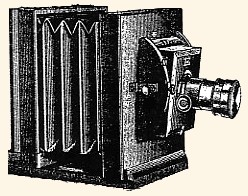Photographing Heaven
 Spiritualists found inspiration in the invention of photography, which Louis Daguerre had first exhibited in 1839. Photography bridged the gap between different times and places (the past and the present, the distant and the near), analogous to the spiritualists’ bridge between heaven and earth. Photography appeared to offer proof that the intangible could act upon the tangible, that spirit could inform the world, or even that mind could act directly upon matter.
Spiritualists found inspiration in the invention of photography, which Louis Daguerre had first exhibited in 1839. Photography bridged the gap between different times and places (the past and the present, the distant and the near), analogous to the spiritualists’ bridge between heaven and earth. Photography appeared to offer proof that the intangible could act upon the tangible, that spirit could inform the world, or even that mind could act directly upon matter.
Photography also seemed to give light a redemptive power and to make possible both a scientific as well as occultic aesthetic of illumination. In 1836, just a few years before Daguerre’s first demonstration of photography, Ralph Waldo Emerson had written in his essay Nature, “There is no object so foul that intense light will not make beautiful.” Capturing a spirit on a photographic plate dissipated the foul shadow of death. Spiritualists hoped it would serve not only as a means of collecting objective evidence that could prove to others the existence of the spirits seen at a séance but also as a means of investigating the invisible spirit realm by registering on photosensitive material images that the eye was otherwise incapable of apprehending.

Do You Believe? exhibit by Bill Becker on spirit photography, at the American Museum of PhotographyConcerning the Spiritual in Photography, at the Photographic Resource Center at Boston University
Jack and Beverly’s Spirit Photographs (nice stereo views)
A spirit photograph of a photograph, at the George Eastman House Archive
Old spirit photos at the International Survivalist Society
For a Limited Time:
And the equally-amazing book that accompanies the exhibition:
The Perfect Medium: Photography and the Occult. New Haven, Connecticut: Yale University Press, 2005. By Clément Chéroux, Andreas Fischer, Pierre Apraxine, Denis Canguilhem, and Sophie Schmit.
In a sense, spirit photography was a precursor to modern art, at least in that its aim was to make truths that were ordinarily invisible visible, to represent a reality that could not otherwise be given an ordinary, conventional form.
Tracy Emin’s Interest in Mysticism, by Renee Vara, at Chubb Collectors
In another sense, spirit photography was a technological means to a spiritual end—the shades of those who lived in the past could be brought into the present and those living now could be made to appear in the future. It was at least a simulacrum—if not an actual annunciation—of the end of time, when the spirits of all times and places would commune together, and all concealed things made plain.
A gentleman who is an expert in science says that he can demonstrate that the photographic instrument can photograph invisible substances. Thus mankind are getting ready to take the spirit form, to establish the beautiful fact, by photographic developments. Art has made the nearest approach to painting unsubstantial shadows, so that the human eye can, with admiring satisfaction, look upon them. Perhaps, in this manner, one of these days, Art will catch the fragrance of a flower, so that you can take the likeness of an odor to your friends! Men will then say, “Is it possible that for centuries we have been only able to smell without seeing, while now we can see what we have known only by the olfactory nerves?”
—Andrew Jackson Davis, Death and the Afterlife, 1865: 68.
Early attempts at spirit photography
Some of these ideas provided a general background for the practical and successful experiments of Philadelphia photographer and spiritualist Isaac Rehn.
Isaac Rehn’s “everlasting” images
These ideas also provided the background for others’ less practical and less successful attempts—either to photograph spirits, or to get the spirits to transfer pictures of the afterlife or the spirit realm onto paper in the séance room, which became a kind of “darkroom” for developing images.
Elizabeth French’s “instant” images
The spiritual world seemed to be precipitated into—or reproduced in—the material world, reconciling religion and science.
The photographic studio as séance room
The project of spirit photography suggested a visionary, intuitive aesthetic, as well as a need for technology that would make it possible. Photography was only one of the first technologies, however, that spiritualists would employ in bridging the gap between matter and spirit, between this world and the next. As each new communications technology developed, spiritualists used it to search for contact with the deceased. Telephones, telegraphs, fax machines, radios, televisions, sound recorders, movie cameras, video cameras, computers with internet connections, radar receivers, and radio telescopes have all been used.
World ITC (Instrumental Transcommunication)
A Few More References:
Ferris, Alison. The Disembodied Spirit, exhibition catalogue, with essays by Tom Gunning, Pamela Thurschwell, and Ferris, Bowdoin College Museum of Art, 2003.
Gunning, Tom. “In Your Face: Physiognomy, Photography, and the Gnostic Mission of Early Film,” in Modernism/Modernity 4:1 (1997):1-30.
Gunning, Tom. “Phantom Images and Modern Manifestations: Spirit Photography, Magic Theatre, Trick Films, and Photography’s Uncanny,” pp. 42-71 in Fugitive Images: From Photography to Video, edited by Patrice Petro (Bloomington: Indiana University Press, 1995).
Krauss, Rolf H. Beyond Light and Shadow, The Role of Photography in Certain Paranormal Phenomena: An Historical Survey (Munich: Nazraeli Press, 1994).
Sconce, Jeffrey. Haunted Media: Electronic Presence from Telegraphy to Television (Durham & London: Duke University Press, 2000).
Art Journal, Themed Issue: Photography and the Paranormal, including essays by Mark Alice Durant, Louis Kaplan, Karl Schoonover, Alison Ferris, and Jane D. Marsching, College Art Association, 62:2 (Fall 2003).
::::::::::::::::::::::::::::::::::::::::::::::::